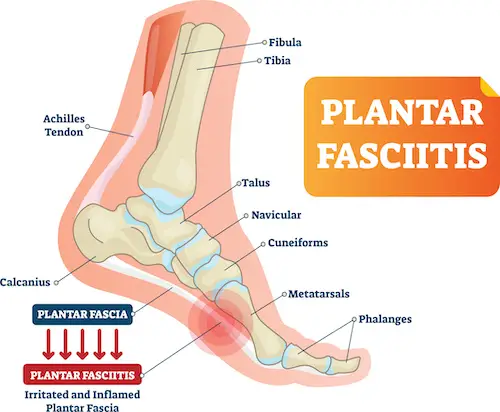Plantar fasciitis is a condition of the heel joint and the sole of the foot that causes pain. It can also be called heel spurs, heel bone spur, or simply heel bone. It may occur on its own without any apparent cause, or it can form when other conditions of the foot, such as arthritis, are present.
What Causes Plantar Fasciitis?
Plantar fasciitis can have a variety of causes. In most cases, this condition does not develop on its own. Instead, it often develops after another condition has caused inflammation or irritation of the heel joint and plantar fascia.
One of these reasons is an injury to the foot, specifically to the plantar fascia tendon. If this tendon gets inflamed or irritated, it becomes thick and rigid and becomes difficult to stretch.
Other causes include injury to the tendons that support the arch in the foot, a fracture, or damage to the ligaments of the foot. Some other conditions that can cause this condition are bunionitis, corns and calluses, or heel spurs.
In order for what is plantar fasciitis to clear up, you will need to get rid of the aggravating condition so that the plantar fascia can heal and regain its elasticity. If severe pain or injury happens, the treatment plan would include surgical intervention. Check out some resources to get more information.
How to Manage the Symptoms of Plantar Fasciitis
To begin treating what is plantar fasciitis, the first step is to determine what the actual problem is. In most cases, the cause is something simple.
If a runner has a heel spur or bunion, it will be necessary to treat those conditions as well. If, however, the heel spur or bunion hasn’t developed yet, they will have to be treated by themselves.
Rest
In the case of an injury to the tendons supporting the arch in the foot, the first step to treatment is to rest the injured foot and work on strengthening them in the meantime.
Ice
An ice compress is an easy and effective way to manage pain associated with treat plantar fasciitis. Make an ice pack by wrapping a towel around a plastic bag that is filled with crushed ice.
A good alternative to ice would be frozen peas or corn. Apply the ice pack on your heel for at 15 to 20 minutes three time a day.
Contrast Bath
If you are wondering if you should use a contrast bath on plantar fasciitis, the answer is yes. The reason why it is important to use a contrast bath on plantar fasciitis is because it will make your feet less painful.
A contrast bath means bathing the injured or sore limb alternatively between a cold basin and a hot basin. Alternating the heat and the cold allows to reduce swelling, soothe sore muscles, and reduces pain.
Orthotics
When the condition is in its early stages, it may be necessary to use orthotics to help support the plantar fascia and provide some level of relief.
The orthotic supports the bones and prevents the tendons from being pulled apart from one another. You can add a support cushion to your footwear to provide your arch and your tendons with adequate support as they heal.
Night Splints
Splints keep your feet – or whatever the effect limb is – in an ideal position for the limb to properly heal and make sure all bones, tendons, and ligaments heal in the places they are meant to heal.
Night splints are a great product for pain relief in plantar fasciitis as they relieve the discomfort at the night and keep your foot in the right position even if you’re a restless sleeper. You can also find similar equivalents for use during the day.
It is important for you to make sure that you are wearing night splints for the recommended amount of time. Make sure that night splints are worn correctly because they can be uncomfortable and cause an increased pressure on the plantar fascia if they are not used properly.
Night splints have several benefits, including the following:
- Protects the Foot: They are very comfortable and also help to prevent your foot from rubbing against the deck of your shoe, which can cause irritation and make your condition worse.
- Promote Better Sleep: Many people that wearing night splints find that they have an increased ability to sleep at night, and it helps to eliminate some of the discomfort associated with plantar fasciitis. This is due to the fact that your foot is flexed in such a way that helps gently stretch tight tendons and aligns all of the parts of your foot into the proper arrangement for beneficial healing.
- Reducing Severity of Plantar Fasciitis: Night splints are also beneficial in reducing the severity of the condition because the pressure is distributed more evenly throughout the entire area of the foot. Because of the distribution of pressure, your arch does not become compressed or irritated, which means that the condition does not occur as quickly.
- Increase Flexibility: When you apply night splints to plantar fasciitis, they work to increase your flexibility, which allows the treatment to reach deep into the areas of the plantar fascia and prevents the condition from causing too much damage.
If your doctor recommends that you stop wearing the splints, there are some other steps you can take to reduce the severity of the condition.
Exercise
Heels hurt so bad that you can barely walk? Perhaps you have already picked up jogging or even started training for the first marathon this year; until now, your heel has been an irritant, causing you pain every step of the way.
Or perhaps, you were told to sit up straight, and now you're feeling a sharp, stabbing pain in the heel that you can hardly bear. All of these are possible signs of plantar fasciitis.
Increasing your activity level can improve circulation in your feet and reduce the inflammation. There are also some exercises that can be done to increase the blood flow in the area, which can relieve the swelling, so you should continue with these treatments for a longer period of time.
If the pain persists, you should consult with your doctor to determine what type of treatment is best for you.
There are basic exercises for plantar fasciitis exercises you can do at home before locking yourself into the couch, such as the following:
Pain Medications
Treatment for what is plantar fasciitis will depend on the type of condition that is present. If the condition is caused by arthritis, the doctor will prescribe anti-inflammatory medication in order to reduce pain and pressure and to help to prevent further problems from developing.
In the case of heel spurs and bunion, a good treatment is pain killers that will help relieve the pain in the plantar fascia.
Weight Management
You can prevent the pain of plantar fasciitis from worsening by keeping your weight in the proper range. If you are overweight, then you need to be especially careful with your ankles as they will be working harder for you. Also, if you have weak ankles, then this may also be causing the problem.
Wear Comfortable Shoes
One thing to keep in mind is that if your shoes are too tight, then that will aggravate the plantar fasciitis. This will ensure that your feet are more flexible and will allow for the plantar fascia to stretch properly.
This can also make a difference in how much traction you get from your shoe and will make it easier to walk around without feeling too much pain.
Physical Therapy
In addition to using the above-mentioned treatment methods, there are also several physical therapies that can be used for plantar fasciitis. For example, foot spa massage can help to decrease inflammation and stiffness.
Also, stretching the plantar fascia can improve the flexibility and give the foot a wider range of motion. There are also stretches that can be performed at home, such as walking or running, that will strengthen the plantar fascia and help it heal.
Ultrasound Therapy
Another alternative that has been effective for some patients who suffer from plantar fasciitis is the use of ultrasound therapy. This treatment will target the fascia, which is a soft tissue located between the bones that is responsible for the arch, and help to relieve pressure and strain on the plantar fascia.
Surgical Intervention
If you have been diagnosed with plantar fasciitis, you will need to schedule an appointment with a podiatrist. A podiatrist will be able to examine your foot and determine what is causing the pain, which will give them a better idea as to whether you need surgery and, if so, which type of surgery will be needed to repair the injury.
If the pain is so severe that you cannot continue your normal activity, it would require surgical intervention to relieve it. You should talk with your doctor about your situation before deciding on a procedure.
Here are the following surgical interventions for plantar fasciitis:
Conclusion
There are many ways to help treat the signs and symptoms of plantar fasciitis. Depending on the severity of the plantar fasciitis and what other conditions either caused it or are complicating it, you have a variety of treatment methods to choose from to address the issue. Some will be better than others depending on your personal situation and other conditions.
It is important to rest the affected foot to prevent further damage on the tissues. By using a foot support, arch supports, or an arch cushion, you can reduce the pain in your bottom of the foot and improve the strength and range of motion of your arch and decrease the chance of the development of a recurrence of plantar fasciitis.
Exercising, ultrasound therapy, contrasting bath, and massage therapy can also help relieve pain associated with plantar fasciitis. Your doctor may prescribe pain killers and anti-inflammatory medications too. The last resort in treating severe plantar fasciitis that disrupts normal routines is surgery.

Lauren Gamble is an author, mompreneur, co-founder of Naturally Made Essentials. She is on a mission to help thousands of women across the world achieve a healthy, happy lifestyle through teaching natural health practices.

